Delhi: N
This is a collection of articles archived for the excellence of their content. |
Contents |
Najafgarh
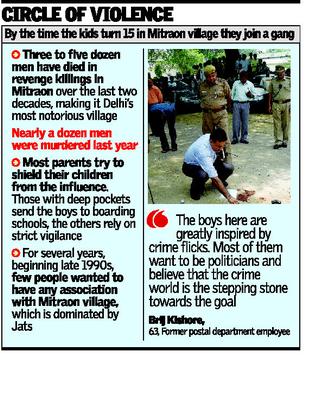
The Hindu, January 25, 2016
Shiv Sunny
Gangsters are legends in this village
Elders of the notorious Mitraon village in Najafgarh rue the loss of a generation to violence.
If anyone ever suggests ‘Fauzi’ or ‘Balraj’ during the naming ceremony of a child in this village, they draw scornful and warning stares. But these are the very names many children demand to be rechristened with when they breach their teens.
Welcome to Mitraon village in Najafgarh area in South West Delhi whose younger generation idolises gangsters like Fauzi and Balraj — they are nothing less than “legends” for the teenagers here.
As per various estimates, three to five dozen men have died in revenge killings in Mitraon over the last two decades, making it arguably Delhi’s most notorious village. Since the start of last year, when four villagers were found charred in a car, around a dozen men have already been murdered.
It all began over a few acres of land in the 1990s. Today, this village has produced some of the most notorious gangsters like Manjeet Mahal, Naveen Khati and Ravinder Bholu.
“Today, the rivalries are no more just over property or money. It is now over a false sense of honour,” says Dependra Pathak, Joint Commissioner of Police (South-Western Range).
The younger lot in this village are inspired by Indian films that show orphans rising from railway tracks to rule over the underworld. They want to imitate gangsters who arrive at the village in suave SUVs with bodyguards flanking them.
Most parents do all they can to shield their children from the influence. Those with deep pockets send the boys away to boarding schools outside Delhi at the first opportunity.
The less fortunate ones rely on strict vigilance. They allow their children to interact with very few friends and track their movements closely.
“There are times when I have paid surprise visits to his school and even secretly followed him by another vehicle to know which places he visits and whom he interacts with,” says Sandeep Gehlot, father to a 16-year-old boy.
For several years Mr. Gehlot kept the TV remote with him. “I allowed my son to watch only children’s shows like Chhota Bheem and Motu-Patlu. He was never allowed to watch gangster films,” says Mr Gehlot, a farmer.
Sandeep is not alone when it comes to monitoring what children watch on TV. “The boys here are greatly inspired by crime flicks. Most of them want to be politicians at a later stage in life and believe that the crime world is the stepping stone towards the goal,” says Brij Kishore, a 63-year-old ex-employee with the postal department.
By the time the children turn 15, they are associated with one of the several small gangs from the village. Once the gang leader is arrested or killed, they see an opportunity to break away and form their own gang.
Even after severe crackdown on the gangs in the past, there are 15-20 small and big gangs operating from the village. A murder here is followed by another and the revenge cycle goes on.
All this takes its toll on the youth, particularly girls, when they reach marriageable age. For several years, beginning late 1990s, few people wanted to have any association with Mitraon village, which is dominated by Jats.
“Many members of our younger generation were unable to find brides or grooms because of fears of early widowhood or getting into legal troubles. The only thing residents of other villages discussed about Mitraon were the gang-wars. It became embarrassing for us to visit another village,” says Om Krishan, a local.
Despite no dip in the crime scene, the marriage situation has improved claim villagers. Yet, it took a retired government teacher of the village two years before he could find a groom for his daughter who was by then “way past her marriageable age”.
“My daughter is a government school teacher and under normal conditions she would have found enough suitors,” says the teacher, insisting that he faced this hurdle despite no one from his family being ever associated with any gang.
The older generation claims to have done their bit to end the rivalries between residents of the around 12,000-strong village. Village elders say they attend weddings at each others’ homes even as their sons and grandsons are warring against one another. But this has had little impact as the young criminal elements show scant regards for their elders. “Even at this age I am scared to smoke in front of my father. But the younger members do not care to even hide their guns when they come home,” says the school teacher.
Amid all this, police have been holding regular meetings with the village heads to keep the youngsters in check, but the ground reality is that they know that a round-the-clock deployment of a good number of police personnel in and around this village is the only way to prevent violence here.
Neb Sarai
Murals and art
The Times of India, Sep 29 2015
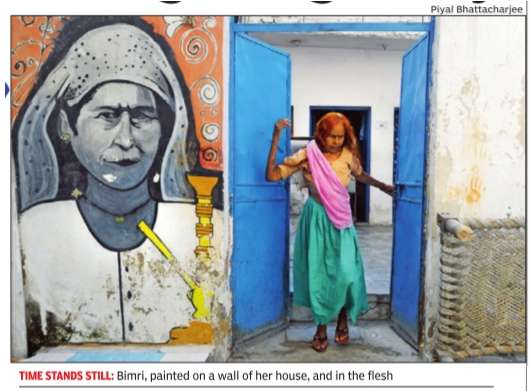

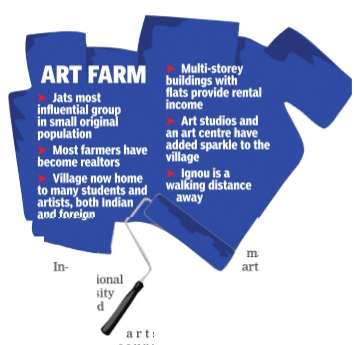
Risha Chitlangia & Richi Verma In Neb Sarai, each wall is a canvas and every street a living art gallery
The pursuit of art and “struggle“ go hand in hand, but for broke artists living on a dream to make it big, Neb Sarai village in south Delhi offers an affordable roof and unlimited canvas space. Most streets in the village have a wall or two painted over with a portrait or abstract art--the work of resident artists. While the villagers don't understand all of the ideas behind the murals, they are appreciative enough to let their own children assist and learn from tomorrow's masters. Without the artists, Neb Sarai is mere haphazard growth--unauthorized and lacking basic amenities for its mushrooming population. But in its middle lies NIV Art Centre that has become a platform for struggling and upcoming artists to sharpen their skills and reach a wider audience. Painters, sculptors, street artists, caricaturists and designers from across the country make it a base in their early careers.
Although NIV opened in 2007, it became popular only after Indira Gandhi National Open University (Ignou) started a masters programme in fine arts.“The full-time course attracted a lot of budding artists, most of whom lived in this village,“ said Avtar Singh, a painter from Punjab who was in the first batch.
Shailesh, a sculptor from Uttar Pradesh, chose to live there because “If you want to make it in the art world, you need to live close to the community .“ He needs to use strongly smelling chemicals that few landlords would tolerate but in Neb Sarai he found space for a studio quite cheaply . He has lived in the village for three years and says, “The locals are cooperative and accommodating. R Ritesh, an art historian who works with Niv Art Centre, said even foreign artists live in the village. “Every year, around 300 art ists come and go at the centre.“
Some artists leave in weeks, others stay on for years. “The vil lage is a perfect loca tion as we are close to the mainstream market, and yet affordable, said Singh. Room rents vary from Rs 5,000 to Rs, 12,000 depending on the space and privacy they offer. Bimri's portrait greets passersby from the outer wall of her house. She let a young artist paint it and says, “It is nice to have these people in the village. They have painted the walls with beautiful colours.“
The 70-year-old has seen Neb Sarai transform from a cluster of “huts and very few pucca houses“ in the days when most of its residents worked as labourers.“This is no longer a village but just like any other colony,“ she added.
Two lanes ahead, Phoolwati proudly shows a mural of monkeys painted on an outer wall of her house. Her 10-year-old son had helped the artist and got to learn from him in return. “He has painted some murals inside the house as well,“ she said.
Nizamuddin basti
Atgah Khan's tomb
Illegal encroachment
Sources:
The Times of India, August 11, 2015
The Times of India, October 3, 2015
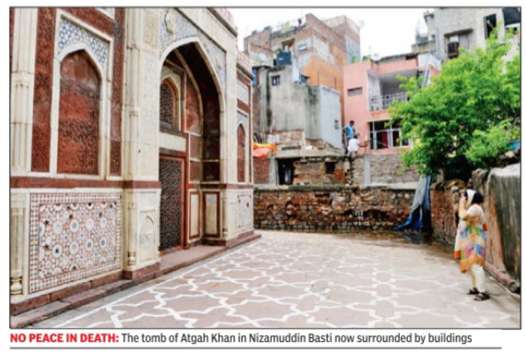
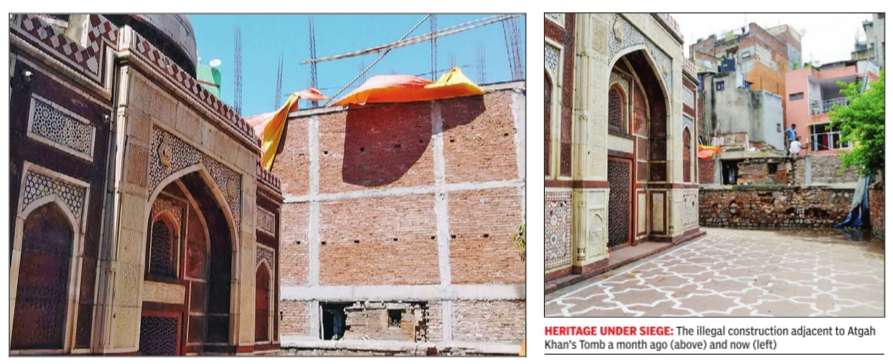
The tomb is situated on the northern edge of Nizamuddin, known for the dargah of the 13th century Sufi saint Nizamuddin Auliya.An inscription on the southern door of the tomb mentions that it was finished in the mid-16th century.
Historians said there were graves in the area around the tomb, where the unauthorized construction was taking place. “Atgah Khan's tomb has a crypt that is much larger than the domed tomb structure. The house is actually being built on the top of the crypt, said a source. The crypt of the tomb has been illegally occupied for many years and the ASI has not been able to get it vacated. The ASI has not found it easy to keep tabs on illegal construction and encroachments around the tomb. The area of Nizamuddin is very densely populated with a number of encroachments near the monument over the past few years.
ASI says monument under threat as Delhi Police And South Corporation ignored its multiple complaints
In 2015, Archaeological Survey of India (ASI) filed a police complaint against an unauthorized construction adjacent to the 16thcentury tomb of Mughal noble Atgah Khan in Nizamuddinbasti. With no action by the authorities, the construction has now materialized into a three-storey building. According to officials, the construction work was first spotted by locals. Locals from the area said that overnight a new building suddenly came up right on top of the wall surrounding the tomb. The illegal building now overshadows the tomb. Historians said that there were graves in the area around the tomb, where the unauthorized building was coming up. “The tomb has a crypt that is much larger than the domed tomb structure. The building is actually being built on the top of the crypt, said a source.
The area is very densely populated, and a number of encroachments have taken place near this monument over the last few years. The crypt of the tomb has been illegally occupied for many years, and Archaeological Survey of India has not been able to get it vacated.